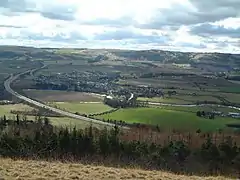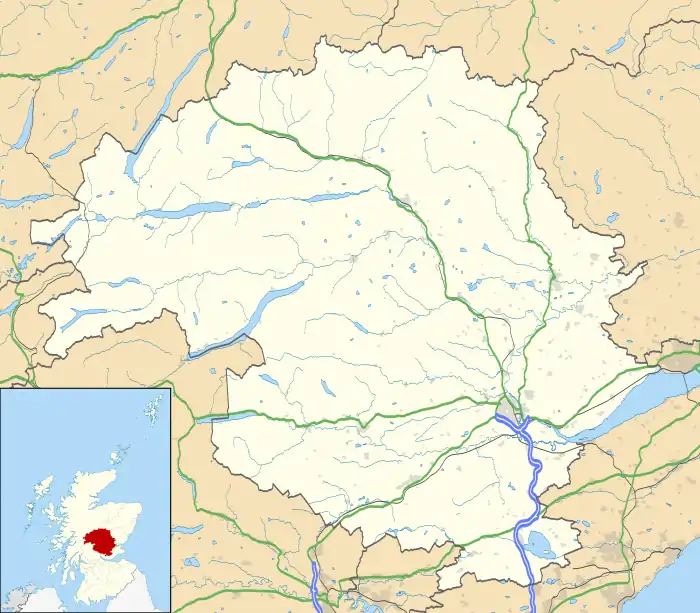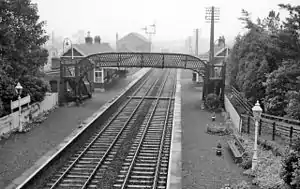Bridge of Earn
Bridge of Earn (Scottish Gaelic: Drochaid Èireann) is a small town in Perthshire, Scotland. Often referred to simply as 'The Brig' (Scots for 'bridge'). The village grew up on the south bank of an important crossing of the River Earn, whose sandstone bridge existed from at least the early 14th century, when it is known to have been repaired by order of King Robert I of Scotland (1306–1329) (site: NO 133 185). Substantial remains of the medieval bridge (rendered redundant by a replacement, still in use, slightly upstream in 1821-22) survived into the 1970s, when almost all the stonework was demolished, for (allegedly) being in a dangerously ruinous condition. This ancient bridge was a major landmark on the road between Edinburgh (39 miles or 63 kilometres south) and Perth (4 miles or 6 kilometres north) for several centuries. The village's oldest houses are to be found lining the road (Back Street/Old Edinburgh Road) leading south from the site of the demolished bridge. Among them are some with 18th-century datestones.
Bridge of Earn
| |
|---|---|
 | |
 Bridge of Earn Location within Perth and Kinross | |
| Population | 2,920 (mid-2020 est.)[1] |
| OS grid reference | NO1102 |
| Council area | |
| Lieutenancy area | |
| Country | Scotland |
| Sovereign state | United Kingdom |
| Postcode district | PH |
| Police | Scotland |
| Fire | Scottish |
| Ambulance | Scottish |
| UK Parliament | |
| Scottish Parliament | |
The ruined Old Bridge of Earn (and part of the village) are featured in the 1857 painting Sir Isumbras at the Ford by John Everett Millais (1829–1896), who often stayed at nearby Perth. There is also an early 19th-century lithograph showing the structure as complete in Sketches of Scenery in Perthshire by David Octavius Hill (1802–1870).
History
Bridge of Earn is the main village in the parish of Dunbarney (sometimes Dumbarney in older documents).[2][3] The place-name is of uncertain (though probably Celtic) origin, and contains the element dun, 'fort'. The ancient ecclesiastical focus of the parish was not within the present village, but about 1.5 km to the west at NO 113 190. The site of the medieval parish church is marked by a walled burial ground a little south of the River Earn. There are no visible remains of the medieval building (or of the medieval village that is said to have adjoined it to the south), but the churchyard contains an interesting collection of 18th-century headstones carved with symbols of mortality, trades etc. In 1689 the church was rebuilt much nearer to the Bridge, by then the main focus of settlement in the parish, at NO 130 185. In 1787 the church was rebuilt yet again, using the same stones, on its present site just to the east of the second, which also became a graveyard. The present congregation is a large and flourishing one, and a modern hall and kitchen has been built adjoining the church in recent years. The parish has recently been merged with Forgandenny, its neighbouring village 3 miles (5 kilometres) to the west.
The remains of two medieval chapels survive in Dunbarney parish, in the grounds of Moncrieffe Estate (originally a private chapel of the Moncrieffe family, now their burial vault), and at Ecclesiamagirdle (pronounced 'Exmagirdle'), a site of probably early Christian origin adjoining Ecclesiamagirdle House (early 17th century) on the Glenearn Estate below the Ochil Hills. It is sometimes suggested that the latter was a parish church in its own right up to the Reformation (1559), though there seems to be no conclusive documentation on this point. The small surviving late medieval building (roofless but largely complete) might seem too modest in size to have served as a parish church. The surrounding graveyard contains several well-preserved gravestones from the 17th and 18th centuries, which are interesting examples of 'folk art'.
The parish of Dunbarney was very much part of the traditional agricultural economy of lowland Scotland up to the late 19th century, with most of the inhabitants engaged in agriculture or associated rural crafts. The traffic on the main north road from Edinburgh also gave a certain scope for the inn and hotel trade to accommodate travellers. From the late 18th century the spa (now closed) at Pitkeathly Wells became an important economic focus, with large numbers of visitors resorting to the parish to 'take the waters'. During the 19th century the coming of the railway to the village and the building of a station (closed in the 1960s) provided a further source of local employment, with much local produce being moved out by rail.
Bridge of Earn has had two railway stations, the second and most recent having closed on 15 June 1964. Bridge of Earn's original station had been located a few hundred yards further east when the existing line first opened on 18 July 1848. This station was closed on 1 February 1892, not as a consequence of economic cutbacks, but rather as a consequence of expansion. The Bridge of Earn to Mawcarse line, which followed closely to the route of the current M90 motorway southwards towards Balmanno Hill, before cutting right through the heart of it via the two tunnels which still exist today, opened to passengers on 1 June 1890. It made logistical sense to move Bridge of Earn's station to a better position to accommodate this new junction and so the original station was replaced. This section of line, between Bridge of Earn and Cowdenbeath, was closed in January 1970, following the Labour government instructions and was not a Beeching recommendation.
Salmon fishing on the Earn (a major tributary of the Tay), was also long an important source of income, though since the late 20th century commercial net fishing on both rivers has died out (sport fishing continues in season).
Since the Second World War, Bridge of Earn has increasingly become a dormitory town for families whose wage-earners commute to Perth, Dundee, Edinburgh or other large towns, and this has led to a great expansion in the numbers of homes being built, and a corresponding increase in the number of local shops and services.
Expansion
Bridge of Earn, and the formerly neighbouring but now conjoined village of Kintillo, have expanded out of all recognition since the 1960s, with hundreds of new homes being built. An entire new settlement called Oudenarde—named for the Flemish town of Oudenaarde—is currently being built on the site of the large former hospital (NO 142 181) to the east of the old village. The financial crisis of 2012 caused a temporary halt in construction, though the project later resumed, with the approach roads under construction as of June 2015.
Bridge of Earn's proximity to Perth, and convenient transport links to Edinburgh and Dundee, make it a desirable 'dormitory' town, though its second and most recent railway station was closed on 15 June 1964, following the Beeching reforms of the 1960s.
Sport
The local amateur football team Bridge of Earn AFC (who compete in the Kingdom of Fife AFA Championship) play their home fixtures at Victory Park.
The local Bridge of Earn Bowling Club on Main Street is one of the oldest (founded in 1859 on land leased to the village by Sir Thomas Moncreiffe) and largest sports clubs in the village.
Facilities
Apart from the parish church and the primary school, the facilities in the village include three parks (Victory, Balmanno & Kintillo), a bowling club, tennis courts, three pubs (Last Cast, Cypress Inn & Village Inn), one restaurants (Village Inn), a dentist, Used car dealership/ garage (Cargill's Auto Repairs) and several shops including The Co-operative Food supermarket, a newsagents (S&V Newsagents), a bakery (Tower Bakery), two hairdressers (Tanya Black's & Little Hair Company), a Chinese takeaway (Wok In) and a small family run Indian restaurant and takeaway (The Spice Garden above the Village Inn).
There are also self-catering holiday lodges in Bridge of Earn by the banks of the River Earn (River Edge Lodges).
The spa at the neighbouring hamlet (1 mile or 1.5 kilometres west) of Pitkeathly Wells was formerly well-known and popular as a health and social resort, but was closed in 1949.

Education
The village school is Dunbarney Primary School (run by Perth and Kinross Council), which was extended and modernised in 1996.
Dunbarney Primary School is a feeder school for Secondary Bertha Park High School in the north of Perth, Scotland.
The Carloways, an upcoming band were classmates at Dunbarney Primary School. The band have toured Scotland for over 4 years and have played as Alex Salmond's house band on his Edinburgh fringe tour and Scottish nationwide tour. The Carloways have played at Belladrum tartan heart festival for the past 4 years and released their well-received debut EP in July 2018. The band intend to record their debut album in 2018 or early 2019.
On the south west outskirts of the village, there is the independent Kilgraston School, which is centred upon a mansion house built around 1800 by Francis Grant of Glenlochy.
Estates
Local estates that surround the village (none of whose houses are open to the public) include Moncreiffe House (the seat of the ancient family of Moncrieffe), Glenearn House (with early 17th century Ecclesiamagirdle House in its grounds), and Dunbarney House.
Hospital
Bridge of Earn Hospital was established as an Emergency Hospital Service facility in 1939. It finally closed in 1992.[4]
See also
References
- Citations
- "Mid-2020 Population Estimates for Settlements and Localities in Scotland". National Records of Scotland. 31 March 2022. Retrieved 31 March 2022.
- Beatson 1791.
- Cumming 1845.
- "Bridge of Earn Hospital". Historic Hospitals. 26 April 2015. Retrieved 2 February 2019.
- Sources
- Beatson, David (1791). "Parish of Dunbarny". The statistical account of Scotland. Drawn up from the communications of the ministers of the different parishes. Vol. 8. Edinburgh: W. Creech. pp. 401-406. Retrieved 18 July 2020.
- Chisholm, Hugh, ed. (1911). "Earn". Encyclopædia Britannica. Vol. 8 (11th ed.). Cambridge University Press.
- Cumming, Alexander (1845). "Parish of Dunbarny". The new statistical account of Scotland. Vol. 10. Edinburgh and London: William Blackwood and Sons. pp. 790-825. Retrieved 18 July 2020.
- Groome, Francis, Hindes (1882a). "Earn, Bridge of". Ordnance gazetteer of Scotland : a survey of Scottish topography, statistical, biographical, and historical. Vol. 1. Edinburgh: T.C. Jack. p. 460.
{{cite book}}: CS1 maint: multiple names: authors list (link) - Groome, Francis, Hindes (1882b). "Dunbarny". Ordnance gazetteer of Scotland : a survey of Scottish topography, statistical, biographical, and historical. Vol. 2. Edinburgh: T.C. Jack. pp. 409-409.
{{cite book}}: CS1 maint: multiple names: authors list (link) - Groome, Francis, Hindes (1882c). "Kintulloch". Ordnance gazetteer of Scotland : a survey of Scottish topography, statistical, biographical, and historical. Vol. 4. Edinburgh: T.C. Jack. pp. 411.
{{cite book}}: CS1 maint: multiple names: authors list (link) - Lewis, Samuel (1851). "Earn, Bridge of". A topographical dictionary of Scotland, comprising the several counties, islands, cities, burgh and market towns, parishes, and principal villages, with historical and statistical descriptions: embellished with engravings of the seals and arms of the different burghs and universities. Vol. 1. London: S. Lewis and co. p. 366.